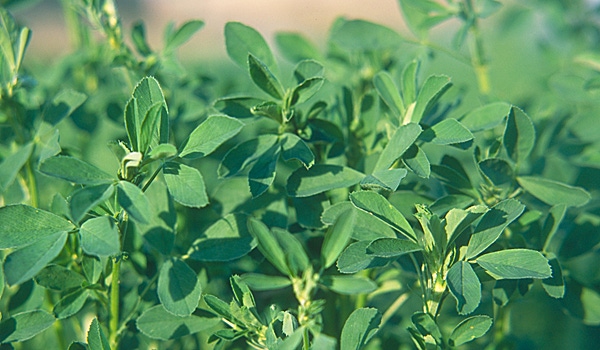June 6, 2013

Gypsum applied to alfalfa fields can help growers increase tonnage and quality, says Ron Chamberlain, director of gypsum programs for Gypsoil/Beneficial Reuse Management, Chicago.
Here are five reasons gypsum is beneficial for alfalfa:
No. 1: Excellent sulfur source
As federal regulations require power plants burning coal to meet stricter regulations there’s less sulfur deposited on farm fields. Alfalfa is a sulfur-loving crop and deficiencies are not unusual. In fact, 82% of soil samples in one Midwestern state in a recent research study tested low for sulfur.1 In addition, a 2010 University of Wisconsin plant tissue study showed that 64% of samples were low in sulfur even when the majority of alfalfa plants appear normal.
“For every 10 pounds of nitrogen used to build protein in alfalfa, one pound of sulfur is removed from the soil,” Chamberlain says.
No. 2: Reduces water stress
The stress from having too much or too little water is the top reason why crop yields vary, says crop consultant Joe Nester, who owns Nester Ag, Bryan, Ohio.
“You’ve got to move water and air through the soil,” Nester says.
Nester advises growers to look at soil tests, check the CEC and see if water infiltration is a problem. In soils with a higher CEC and more clay content, Nester says he is more concerned about calcium and magnesium levels.
“I would address the calcium needs first and then apply gypsum to manage magnesium levels where they are detrimental to water infiltration and soil health,” Nester says. “Gypsum is like a firecracker. When you use it on those high-clay soils, it helps separate the clay particles, so water and air can enter in.”
No. 3: Fights compaction
When the soil is compacted, biological activity can be limited because there is less oxygen in the soil, Chamberlain says.
“Oxygen needs to be present in the soil for the biology to work efficiently,” Chamberlain says. “In waterlogged soils the biology shifts from aerobic to anaerobic. This drastically slows the decay of crop residues, and you don’t get optimal mineralization of nutrients from the soil parent material.”
No. 4: Feeds the soil
A direct connection exists between soil health and feed digestibility, according to Tom Weaver, who is director of Kow Consulting Association, Darlington, WI.
“Dairy nutrition needs to start in the soil,” says Weaver, who consults with dairy farmers in Wisconsin, Minnesota and Illinois. “Balancing calcium and potassium has the benefit of improving both fiber digestibilty and non-fiber carbohydrates. Gypsum typically contains about 20-21% calcium, much of which is water soluble.”
Weaver continues: “The readily available sulfate-sulfur in gypsum is essential to build high quality protein in forages,” he says.
5. Enhances hay quality
Alfalfa growers that use gypsum often comment on how much healthier their alfalfa looks after even one application. The greener and leafier appearance is likely due to the improved nutrient status and improved soil structure over time. Healthier soils contribute to healthier plants that withstand stress and weather fluctuations. “When we look at test strips the gypsum-applied fields typically look much more robust and thriving,” Chamberlain says.
For more information, visit www.gypsoil.com.
Like what you're reading? Subscribe to Farm Industry News Now e-newsletter to get the latest news and more straight to your inbox twice weekly.
PLUS - You might also like:
Iowa State University updates soil productivity rating methods
Biochar could be answer for improving impaired soils, research indicates
Crop yield forecasting app can now utilize GPS soil testing data
You May Also Like




